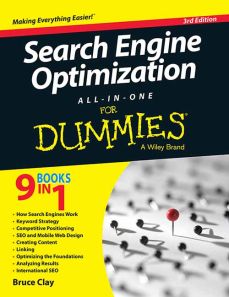Search Engine Optimization All-In-One for Dummies, 3ed
ISBN: 9788126558759
792 pages
For more information write to us at: acadmktg@wiley.com

Description
In Search Engine Optimization All-in-One For Dummies, 3rd Edition, Bruce Clay—whose search engine consultancy predates Google—shares everything you need to know about SEO. In minibooks that cover the entire topic, you'll discover how search engines work, how to apply effective keyword strategies, ways to use SEO to position yourself competitively, the latest on international SEO practices and more. If SEO makes your head spin, this no-nonsense guide makes it easier. You'll get the lowdown on how to use search engine optimization to improve the quality and volume of traffic on your website via search engine results.
Introduction
Part I: Getting Started
Chapter 1: An Introduction to Tizen
- Discovering Tizen
- The Tizen Association and Tizen Project
- The Tizen Ecosystem
- Reasons for Programming in Tizen
- Tizen Is Based on Standards
- Tizen Is Open
- Tizen Is Heterogeneous
- Tizen Has Industry Support
- Installing the Tizen SDK
- Prerequisites
- Installing the SDK
- Creating the Tizen Hello World Web Application
- Creating the Hello World Tizen Native Application
- Signing the Hello World Application
Chapter 2: Tizen Application Packages
- Packaging a Web Application
- Packaging a Native Application
- Packaging a Hybrid Application
- Using Optional Features
- Using Privileged APIs
- Signing a Package
Chapter 3: Tizen Development Tools
- The Tizen IDE
- Tizen Emulator
- Enabling Hardware Acceleration
- Using the Tizen Emulator
- Tizen Web Simulator
- Smart Development Bridge
- Debugging and Testing
- Designing the UI with the UI Builder
Part II: Tizen Web APIs
Chapter 4: Web Application Fundamentals
- The Web Runtime
- Tizen Device APIs
- Tizen Web UI Framework
- Overview of the Tizen Web UI Framework
- The Basics of jQuery Mobile
- Using the UI Builder
- Choosing Your Widgets
- Implementing Events in the UI Builder
Chapter 5: Location-Based Services
- Displaying a Map
- Detecting a User's Location
- Monitoring the User's Position
- A Word of Caution
- Adding Markers to a Map
- Geocoding and Reverse Geocoding
Chapter 6: Multimedia
- Discovering Multimedia Content
- Embedding HTML5 Audio and Video
- Capturing Images
- Creating a Simple Camera Application
- Capturing an Image
Chapter 7: Sensors and Other Hardware
- Device Orientation
- A Working Example
- Near Field Communication (NFC)
- Using NFC in Your Web Applications
- Peer-to-Peer Mode
Chapter 8: Messaging Services
- Messaging Service
- E-Mail Client Example
Chapter 9: Contacts and Calendars
- Setting Privileges
- The Contact API
- Address Book
- Contacts
- Person Objects
- The Calendar API
- Calendar Events
- Calendar Tasks
- Adding Events
- Getting Events
- Updating Events
- Creating Recurring Events
- Setting Alarms
- Converting Events to iCalendar Format
Chapter 10: Native UI Applications
- UI Framework Architecture
- Types of Native UI Applications
- Native UI Application Life Cycle
- State Transition Flow
- Initialisation and Termination
- Application and Frame States
- Creating a Form and Handling Events
- Handling UI Events
- Handling Hardware Keys
- Handling Gestures
Chapter 11: Native Application fundamentals
- Basic Idioms and Styles
- Error Handling
- Debugging Macro Functions
- Two-Phase Construction
- The RAII Idiom
- Transferring Object Ownership
- Fundamental Data Types
- Object
- String
- Collection
- STLConverter
- DateTime and TimeSpan
- ByteBuffer
Chapter 12: Native UI Controls
- An Overview of UI Controls
- Using Containers
- Popups
- Panels
- Layout
- Coordinate System
- Using UI Controls
- Button
- EditArea, EditField

